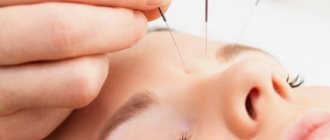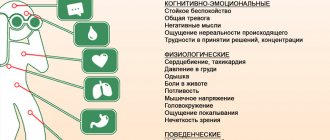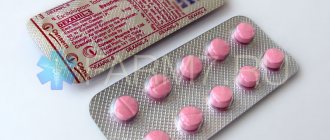Fluoxetine is one of those drugs that is not recommended for use during pregnancy. It is an antidepressant widely used to treat depression and other mental disorders. They occur as often in pregnant women as in the general population. However, it is better to avoid taking fluoxetine at this time.
Overdose
Regardless of food intake, orally. Depression Initial dose – 20 mg once a day in the morning.
The dose can be increased to 40 – 60 mg/day. Then it must be divided into two or three doses. The maximum dose per day is 80 mg of medication. Obsessive-compulsive disorders Fluoxetine 20 - 60 mg per day. Bulimic neurosis Dosage 60 mg per day is divided into two to three doses. Premenstrual dysphoric disorders Fluoxetine 20 mg per day. In old age, with liver diseases, therapy begins with 1/2 dose. For patients with impaired renal function, reduce the dose and increase the interval between doses drug. The course of treatment is 3 – 4 weeks.
https://www.youtube.com/watch?v=ytadvertise
Symptoms: nausea, vomiting, restlessness, state of agitation, convulsive disorders, disruption of the cardiovascular system. Treatment: no specific antidote has been found. Symptomatic therapy is carried out, gastric lavage, the administration of activated charcoal, for convulsions - the administration of tranquilizers, maintaining cardiac activity and breathing.
An overdose of Fluoxetine is accompanied by: nausea/vomiting, convulsions, hypomania, anxiety, agitation, grand mal seizures.
A high dose of the drug in combination with codeine, maprotiline, temazepam can be fatal.
A victim of an overdose should rinse the stomach, give sorbitol, enterosorbent and, for convulsions, diazepam. Monitoring of respiratory activity and parameters characterizing the functional state of the heart is also important. Subsequently, symptomatic and supportive therapy is carried out.
Peritoneal dialysis, blood transfusion, hemodialysis, and forced diuresis are ineffective.
If the patient suffers from depression, then the initial dose of the medicine for him should be 20 mg - taken once a day, in the first half of the day. Food intake does not matter. In the future, if necessary, the dosage is increased to 40-60 mg/day - necessarily divided into 2-3 doses. The daily dosage should not exceed 80 mg. In other cases:
- When diagnosed with bulimic neurosis and for elderly patients, this drug is prescribed in a daily dosage of 60 mg, which is divided into 2-3 doses.
- For obsessive-compulsive disorder, the recommended dose of an antidepressant is from 20 to 60 mg per day.
- If the patient has premenstrual dysphoric disorders, then the recommended dosage is 20 mg/day.
The course of treatment depends on the specific case and individual characteristics of the body. In general, in most cases it is calculated for 3-4 weeks. It should be taken into account that if you are old or have liver disease, treatment should begin with half the prescribed dosage. In patients suffering from impaired renal function, the dose should also be reduced and the interval between doses of the drug should be increased.
In case of an overdose of an antidepressant, nausea and vomiting, motor restlessness, convulsive disorders, and dysfunction of the cardiovascular system may occur. In addition, the patient may experience a state of agitation. No specific antagonists to the drug have been found, therefore, in case of overdose, gastric lavage, symptomatic therapy and activated angle are prescribed. If patients experience convulsions, then tranquilizers are prescribed to maintain cardiac activity and breathing.
Taking fluoxetine during different periods of pregnancy
Pregnancy is usually divided into three trimesters, so data on taking fluoxetine is also divided into these periods. It has been statistically proven that in the first trimester this drug can cause developmental disorders of the cardiovascular system in the fetus.
The first trimester is the most critical; at this time, all organs and tissues are formed. A mother who took fluoxetine may give birth to a child with heart defects or vascular abnormalities. In the first trimester, this drug is strictly prohibited.
No such pattern was found when taking fluoxetine in the second and third trimesters. However, the active substance penetrates the placenta and therefore enters the fetus. It is not recommended to take it in these two trimesters. However, it has been proven that depression can cause much more harm to the mother and child than the drug.
If absolutely necessary for severe depressive episodes, fluoxetine is considered. In this case, minimal dosages are used and only in the absence of pregnancy complications. If possible, it is better to do without drugs.
Compound
The content of fluoxetine hydrochloride in one capsule is 22.36 mg, which corresponds to fluoxetine 20 mg. This is the active ingredient of the medicine. Additional substances: pregelatinized corn starch, dimethicone. Capsule body composition: gelatin, titanium dioxide, yellow iron oxide dye. The capsule cap contains gelatin, patented blue dye V, titanium dioxide, yellow iron oxide dye.
Fluoxetine tablets contain 20 mg of fluoxetine, as well as lactose monohydrate, gelatin, corn starch, calcium stearate, povidone, silicon (Si) colloidal dioxide, talc, light magnesium (Mg) carbonate, tropeolin 0, additive E171 (titanium (Ti) ) dioxide), mineral oil, sugar, yellow wax.
special instructions
When treating patients with low body weight, anorexigenic effects should be taken into account when prescribing the drug.
Diabetics may develop hypoglycemia during treatment with Fluoxetine, and hyperglycemia after discontinuation of the drug. Taking this into account, it is recommended to make changes to the dosage regimen of insulin and/or oral hypoglycemic agents. Until the clinical picture improves, patients with diabetes mellitus should be under constant medical supervision.
During the treatment period, it is necessary to refrain from engaging in activities that require a high speed of psychomotor reactions and increased attention.
The tablets contain lactose, so they should not be taken if you have galactosemia, lactase deficiency, or glucose/galactose malabsorption syndrome.
Like other antidepressants, fluoxetine can cause mood disorders (mania or hypomania).
https://www.youtube.com/watch?v=ytcopyright
The central organ of drug metabolism is the liver; the kidneys are responsible for excreting metabolites. Patients with liver pathologies should be prescribed low or alternative daily doses.
In case of renal failure (with Clcr less than 10 ml/min.) after 2 months of treatment using a dose of 20 mg/day. plasma concentrations of fluoxetine/norfluoxetine are the same as in patients with healthy kidneys.
Depression is associated with an increased risk of suicidal ideation and suicide attempts. The risk remains until complete remission. Clinical experience with the drug shows that the risk of suicide increases, as a rule, in the early stages of recovery.
Patients with mental illness and depressive syndrome should be under constant supervision. In placebo-controlled studies in a group of patients receiving antidepressants, it was found that the risk of suicidal behavior is highest in people under 25 years of age.
Patients who have been switched to a lower/higher dose also require special monitoring.
The use of Fluoxetine is associated with the development of akathisia, the subjective symptoms of which are a constant need to be in motion, as well as the inability to sit or stand. These phenomena are especially pronounced in the first weeks of treatment. For patients who have developed such symptoms, the drug is prescribed in the minimum effective dose.
If discontinued suddenly, approximately 60% of patients develop withdrawal symptoms. The likelihood of their occurrence depends on the dose used, the duration of the course, and the level of dose reduction. It is recommended to reduce the dose by titration over 7-14 days.
There are reports of the appearance of subcutaneous hemorrhages, such as purpura or ecchymosis, during treatment with the drug. Therefore, for patients taking oral anticoagulants that affect platelet function and increase the likelihood of bleeding, as well as for patients with a history of bleeding, Fluoxetine is prescribed taking into account the possible risks.
Patients with diabetes mellitus are at risk of developing hypoglycemia during therapy with Fluoxetine Lannacher and hyperglycemia after discontinuation of its use. In this regard, the dose of insulin and other hypoglycemic drugs should be adjusted. Until significant improvements in the treatment of diabetes mellitus occur, the patient should be observed by a doctor.
The time interval between the end of treatment with MAO inhibitors and the start of therapy with an antidepressant should be at least 2 weeks, and between the end of treatment with this drug and the start of therapy with these inhibitors - from 5 weeks or more. Please note that in children and adolescents, as well as young people over 24 years of age with depression and other mental disorders, the drug can increase the risk of suicidal behavior and suicidal thoughts in general. When prescribing antidepressants, weigh the benefits of their use against the risk of suicide.
When treated with the drug Lannacher, all patients should be monitored in order to promptly identify disturbances or changes in behavior in order to avoid the development of suicidal tendencies. During treatment, refrain from drinking alcohol and engaging in potentially dangerous activities that require rapid mental and motor reactions and increased attention. An effect on the ability to control machinery and drive vehicles was noted.
Comparing the safety of Paxil and Fluoxetine
The safety of a drug includes many factors.
At the same time, with Paxil it is quite similar to Fluoxetine. It is important where the drug is metabolized: drugs are excreted from the body either unchanged or in the form of products of their biochemical transformations. Metabolism occurs spontaneously, but most often involves major organs such as the liver, kidneys, lungs, skin, brain and others. When assessing the metabolism of Paxil, as well as Fluoxetine, we look at which organ is the metabolizing organ and how critical the effect on it is.
The risk-benefit ratio is when the prescription of a drug is undesirable, but justified under certain conditions and circumstances, with the obligatory observance of caution in use. At the same time, Paxil does not have any risks when used, just like Fluoxetine.
Also, when calculating safety, it is taken into account whether only allergic reactions occur or possible dysfunction of the main organs. In other matters, as well as the reversibility of the consequences of using Paxil and Fluoxetine.
Fluoxetine Lannacher for weight loss
Fluoxetine is often prescribed for bulimic syndrome, a mental syndrome that is accompanied by a lack of satiety and uncontrolled overeating.
The use of the drug reduces appetite and relieves the constant feeling of hunger.
Thus, we can conclude that Fluoxetine can only get rid of excess weight if the reason for its gain is appetite.
However, the drug is not intended for weight loss; its main purpose is to treat depression. Decreased appetite and weight loss are side effects.
https://www.youtube.com/watch?v=ytpolicyandsafety
The medicine is quite powerful, and the body often reacts to its use with anaphylactic reactions and systemic disorders involving the lungs, skin, kidneys and liver in the pathological process.
At the initial stage, diet pills are taken in a minimal dosage - one once a day. If well tolerated, you can switch to taking two tablets - one is taken in the morning, the second in the evening.
The maximum permissible dose is 4 tablets/day.
The drug begins to act after 4-8 hours; it takes about a week to remove fluoxetine from the body.
Reviews on forums confirm the effectiveness of the product - in 1-3 months people got rid of 5-13 kg without much effort. At the same time, all patients who took Fluoxetine note that it is still not worth drinking it just for the sake of losing weight, like Phenibutyl Phenotropil, in the absence of indications.
Some people have a question: is it possible to lose weight with Fluoxetine? In general, it is possible, but you need to take into account that this drug is a potent medicine, which should be used with caution and only in cases where it is impossible to do without it. The drug acts as an anorectic, relieving the constant feeling of hunger and suppressing appetite.
| Pharmacy name | Cost in rubles (20 capsules) |
| Baltika-Med | 123 |
| Zdravzona | 109 |
| Pharmacy Economy | 118 |
| Nova Vita Strogino | 129 |
| Pharmacies on duty on Pervomaiskaya | 129 |
| Pharmacy 777 | 126 |
| Sunny Yasenevo | 130,5 |
pharmachologic effect
Selectively blocks the reverse neuronal uptake of serotonin (5-hydroxytryptamine) at the synapses of neurons in the central nervous system. Suppression of serotonin reuptake increases the concentration of this neurotransmitter in the synaptic cleft, enhances and prolongs its effect on postsynaptic receptor sites.
Fluoxetine has low affinity for α1, α2, and β-adrenergic, serotonin, dopaminergic, muscarinic, H1-histamine and GABAergic receptors. Improves mood, reduces fear, anxiety, tension, eliminates dysphoria, reduces appetite. Causes a reduction in obsessive-compulsive disorders.
Not cardiotoxic. Does not exhibit sedative, hypnotic effects, or orthostatic hypotension. The effect of treatment occurs within 7 to 14 days after taking the drug.
The drug has an anorexigenic effect, eliminates depression and relieves feelings of depression.
Drug interactions
Enhances the effects of hypoglycemic drugs, ethanol, diazepam, alprazolam.
Doubles the plasma concentration of tricyclic antidepressants, phenytoin, trazodone, maprotiline. When prescribing Fluoxetine in combination with tricyclic antidepressants, the dose of the latter should be reduced by 50%.
It may provoke an increase in the plasma concentration of Li, which in turn increases the likelihood of developing its toxic effects. In case of simultaneous use, it is recommended to monitor the concentration of Li in the blood.
Use as an adjunct to electroconvulsive therapy may cause the development of prolonged epileptic seizures.
The serotonergic effects of the drug are enhanced in combination with tryptophan. The likelihood of developing serotonin intoxication increases if taken simultaneously with drugs that inhibit the MAO enzyme.
The likelihood of adverse reactions and increased depressant effects on the central nervous system increases in combination with drugs that depress the central nervous system.
Taking with drugs that are characterized by a high degree of protein binding may provoke an increase in the plasma concentration of unbound (free) drugs, as well as an increase in the likelihood of developing undesirable effects.
The drug should not be used simultaneously with MAO inhibitors, since the development of serotonin syndrome is possible (hyperthermia, chills, increased sweating, myoclonus, hyperreflexia, tremor, diarrhea, impaired motor coordination, autonomic lability, agitation, delirium and coma).
Tryptophan enhances the serotonergic properties of the drug (increased agitation, motor restlessness, gastrointestinal disorders). When used with drugs containing St. John's wort (Hypericum perforatum), an increase in the serotonergic effect and increased undesirable effects may occur.
Increases plasma concentrations of tricyclic antidepressants, phenytoin, maprotiline, trazodone by half. It is necessary to reduce the dose of these drugs by 50% when used simultaneously with Fluoxetine. Enhances the effects of alprazolam, diazepam, ethanol, and hypoglycemic drugs.
The simultaneous use of Fluoxetine with alcohol or with centrally acting drugs that cause depression of the function of the central nervous system enhances their effect and increases the risk of side effects.
https://www.youtube.com/watch?v=cosamomglavnom
Medicines containing lithium should be used with caution due to a possible increase in lithium concentration and the risk of toxic effects. During electroconvulsive therapy, prolonged seizures may develop.
When used simultaneously with drugs that are highly protein bound, especially with anticoagulants and digitoxin, plasma concentrations of free (unbound) drugs may increase and the risk of adverse effects may increase.
Fluoxetine is available by prescription. During treatment with the drug, you should refrain from drinking alcohol and engaging in potentially hazardous activities that require increased attention and speed of mental and motor reactions.
Fluoxetine is produced by Russian pharmaceutical companies FP Obolenskoye, ALSI Pharma, Medicine Production, Ozon, Medisorb, Biocom, Kanonpharma Production, as well as foreign enterprises Apotex Inc (Canada), New Farm Inc (Canada), Hexal AG (Germany), Lannacher (Austria) ).
You cannot use the antidepressant Lannacher simultaneously with MAO inhibitors, because there is a possibility of developing the so-called serotonin syndrome. With it, the patient is faced with impaired coordination of movement, diarrhea, chills, increased sweating, myoclonus and other problems. Drug interactions with other drugs:
- Tryptophan enhances the serotonergic properties of fluoxetine - increased agitation, motor restlessness, and gastrointestinal disorders.
- In plasma, the concentration of tricyclic antidepressants, phenytoin, trazodone, maprotiline increases, almost 2 times. It is necessary to reduce the dosage of the listed drugs by 50 percent if they are taken simultaneously with Fluoxetine.
- When used with products containing St. John's wort, there is a risk of increased serotonergic effect and various undesirable effects.
- The antidepressant Lannacher enhances the effect of Diazepam, Alprazolam, ethanol, and hypoglycemic drugs.
- You should take products containing lithium with caution - it is possible to increase the concentration of lithium and the risk of developing toxic effects.
- Simultaneous use of an antidepressant with centrally acting drugs that cause depression of central nervous system function or alcohol enhances the effect and increases the risk of side effects.
- Prolonged convulsive epileptic seizures may occur during electroconvulsive therapy.
- Concomitant use with drugs with a high degree of protein binding (especially digitoxin, anticoagulants) can lead to an increase in the plasma concentration of so-called free drugs, the risk of adverse effects.
Pharmacodynamics and pharmacokinetics
The active substance of the drug fluoxetine hydrochloride is a white (or almost white) crystalline powder, sparingly soluble in water.
Fluoxetine is a selective serotonin reuptake inhibitor (SNRS). The drug belongs to the pharmacotherapeutic group “Antidepressants”.
Pharmacodynamics
The medicine is intended for oral administration. The mechanism of its action is associated with the ability to selectively (selectively) and reversibly inhibit ONZS.
The antidepressant Fluoxetine has little effect on the uptake of dopamine and norepinephrine and has a weak effect on acetylcholine receptors and H1-type histamine receptors.
Along with antidepressant, it also has a stimulating effect. After taking the tablets/capsules, the patient’s feelings of fear, anxiety and mental tension decrease, mood improves, and symptoms of dysphoria are eliminated.
Wikipedia notes that the drug does not cause orthostatic hypotension, does not have a sedative effect, and is not cardiotoxic.
https://www.youtube.com/watch?v=ytabout
It takes 3 to 4 weeks to achieve a lasting clinical effect with regular use of the drug.
- absorption in the digestive canal is good;
- bioavailability - 60% (orally);
- TSmax - from 6 to 8 hours;
- binding to plasma proteins (including alpha (α)-1-glycoprotein and albumin) - 94.5%;
- T½ - 48-72 hours.
The liver is involved in the metabolism of the substance. As a result of its biotransformation, a number of unidentified metabolites are formed, as well as norfluoxetine, the selectivity and activity of which are equivalent to those of fluoxetine.
Pharmacologically inactive metabolic products are eliminated by the kidneys.
Due to the fact that the substance is excreted from the body rather slowly, the plasma concentration necessary to maintain the therapeutic effect is maintained for several weeks.
Side effects
General disorders that occur during the use of the drug can manifest themselves in the form of hyperhidrosis, chills, fever or sensation of cold, photosensitivity, neuroleptic syndrome, alopecia, lymphadenopathy, anorexia, erythema multiforme, which can progress to malignant exudative or develop into Lyell's syndrome.
Some patients experience symptoms of serotonin toxicity, including:
- changes in mental status (delirium, euphoria, anxiety, agitation, hallucinations, mutism, confusion, mania, coma);
- neuromuscular pathologies (akathisia, coordination disorders, bilateral Babinski's sign, hyperreflexia, myoclonus, epileptiform seizures, nystagmus (horizontal and vertical), oculogyric crises, paresthesia, opisthotonus, tremor, muscle rigidity);
- autonomic dysfunction (hyperthermia, abdominal and headaches, diarrhea, dilated pupils, lacrimation, tachypnea, tachycardia, nausea, blood pressure fluctuations, hyperhidrosis, chills).
From the digestive system of organs, the following are possible: diarrhea, nausea, loss of appetite, vomiting, dysphagia, dyspepsia, change in taste, pain in the esophagus, dry mouth, dyskinesia, liver dysfunction. In isolated cases, idiosyncratic hepatitis may develop.
CNS reactions to taking pills manifest themselves in the form of: bruxism, headache, weakness, sleep disturbances (night delirium, pathological dreams, insomnia), dizziness, fatigue (hypersomnia, drowsiness); disturbances of attention, processes and concentration of thinking, memory; anxiety and associated psychovegetative syndrome, dysphemia, panic attacks, suicidal thoughts and/or attempts to take one’s own life.
Reactions from the urogenital tract: dysuria, urinary retention, lactic and nocturia, protein and albuminuria, polyuria, oliguria, UTI, renal failure, cystitis, decreased libido (to the point of its complete loss), erectile dysfunction, enlarged mammary glands and their soreness , ejaculation disorders, anorgasmia, priapism, impotence, metro- and menorrhagia, painful menstruation.
The possibility of developing:
- immunopathological and allergic reactions;
- myalgia, arthralgia, chondrodystrophy, the appearance of bone pain, osteomyelitis, arthritis and a number of other side effects from the musculoskeletal system;
- vasodilation;
- postural hypotension;
- tides;
- sensations of heartbeat;
- metabolic disorders (including hyponatremia, hypocalcemia, hyper- or hypokalemia, impaired vasopressin secretion, diabetes mellitus, hypercholesterolemia, hyperuricemia, edema, diabetic acidosis, dehydration, hypothyroidism);
- skin reactions (including polymorphic rash, acne, ulcerative lesions of the skin, hirustism, psoriasis, furunculosis, exfoliative dermatitis, etc.).
Discontinuation of drug treatment may provoke withdrawal syndrome, the main symptoms of which are: sensitivity disorders, dizziness, sleep disorders, asthenia, nausea and/or vomiting, agitation, headache, tremor.
Reviews of side effects indicate that the drug is addictive when taken uncontrolled. In some cases, the addiction is so strong that a person requires professional help to treat it.
Other adverse reactions that patients mention in reviews are severe drowsiness, tremors, convulsions, loss of appetite, and nausea. However, there are people who did not experience any unwanted effects at all during treatment.
On the part of the central nervous system, the use of Fluoxetine can cause headache, dizziness, sleep disturbances, asthenia, tremor, agitation, motor agitation, and anxiety. There is a risk of suicidal tendencies, mania or hypomania. Other possible side effects:
- Allergies: itching, skin rash, urticaria, arthralgia, myalgia, fever.
- From the gastrointestinal tract in the form of: vomiting, nausea, decreased appetite, taste disturbances, diarrhea, dry mouth, hypersalivation.
- Genitourinary system: dysmenorrhea, vaginitis, urinary incontinence or retention, decreased libido, sexual dysfunction in men (ejaculation may slow down) may occur.
- Other side effects include: impaired visual acuity, tachycardia, increased sweating, weight loss, vasculitis, the possibility of systemic disorders of the liver, kidneys or lungs.
Dizziness, headache, increased fatigue, asthenia, sleep disturbances, motor agitation, tremor, agitation, increased suicidal tendencies, anxiety, mania or hypomania.
Decreased appetite, dry mouth or hypersalivation, nausea, vomiting, taste disturbance, diarrhea. Allergic reactions in the form of skin rash, itching, urticaria, myalgia, arthralgia, fever.
Urinary incontinence, urinary retention, dysmenorrhea, vaginitis, decreased sexual desire, impaired sexual function in men (delayed ejaculation). Increased sweating, tachycardia, impaired visual acuity, weight loss, systemic disorders of the lungs, kidneys or liver, vasculitis.
Description of drugs
Both drugs were created as antidepressants; they have the same mechanism of action, but due to differences in pharmacokinetics (the processes of absorption and excretion from the body), they are used in different clinical situations.
Pharmacological properties
Fluoxetine
Fluoxetine and dapoxetine belong to the group of serotonin reuptake inhibitors (the “happy hormone”). The meaning of their action is to increase the concentration of this substance in the nervous tissue, against this background the mood improves, vitality and performance increase. Serotonin has an antidepressant effect without suppressing brain function or causing drowsiness or lethargy.
Dapoxetine
Dapoxetine is characterized by rapid action. Unlike other drugs in this group, it is quickly absorbed and removed from the body. In this regard, the drug does not have an effect on depressive disorders, but it affects the ejaculation reflex, delaying it and preventing premature ejaculation.
For comparison: the maximum concentration of fluoxetine in the blood is achieved after 6-8 hours, dapoxetine - after only 1-2 hours; The half-life for fluoxetine is 2-3 days, and for dapoxetine it is 19 hours.
Indications
For fluoxetine:
- depression;
- obsessive states - fixation on certain thoughts and desires, preventing you from concentrating on everyday activities;
- Bulimia nervosa is an eating disorder with bouts of overeating followed by cleansing of the gastrointestinal tract.
For dapoxetine:
- premature ejaculation.
Contraindications
For fluoxetine:
- age under 18 years;
- childbearing and lactation;
- individual intolerance to the drug;
- significantly reduced liver and kidney function;
- concurrent use of other antidepressants.
For dapoxetine:
- severe cardiac pathology (significant arrhythmias without the installation of a pacemaker, impaired contractility of the heart muscle, coronary heart disease associated with insufficient blood supply, uncorrected arterial hypertension or, conversely, low blood pressure);
- severe disorders of the liver and kidneys;
- simultaneous use of antidepressants and some antifungal drugs (intraconazole, ketoconazole);
- hypersensitivity to the drug;
- age less than 18 years
Side effects
Fluoxetine:
- anxiety, irritability;
- sleep disorders;
- dizziness and headaches;
- suicidal thoughts;
- rapid pulse;
- excessive sweating;
- loss of appetite, nausea, diarrhea;
- urinary disturbance;
- menstrual disorder;
- delayed ejaculation;
- allergies.
Dapoxetine:
- nausea, diarrhea;
- dizziness, headache, tinnitus;
- fainting;
- visual impairment;
- nasal congestion;
- anxiety, restlessness, sudden mood swings, sleep disturbance;
- general weakness;
- feeling of heat throughout the body;
- allergic manifestations.
Indications for use: why are tablets and Fluoxetine prescribed?
Obsessive-compulsive disorders. Depression of various origins. Premenstrual dysphoria. Bulimic neurosis.
https://www.youtube.com/watch?v=https:tv.youtube.com
Hypersensitivity to the components of the drug. Severe disorders of renal function (creatinine clearance less than 10 ml/min) and liver. Simultaneous use of monoamine oxidase inhibitors and within 14 days after their withdrawal, thioridazine, pimozide. Bladder atony. Children under 18 years of age. Pregnancy. Lactation .With caution: suicidal mood, epilepsy, diabetes mellitus, excessive weight loss, Parkinson's disease.
Contraindicated during breastfeeding and pregnancy.
The drug is contraindicated during pregnancy, lactation and children under 18 years of age. The antidepressant is used with caution in diabetes mellitus, epilepsy (including a history), Parkinson's disease, excessive weight loss, and suicidal tendencies. In addition, Fluoxetine is contraindicated in:
- simultaneous use of MAO inhibitors and within two weeks after their withdrawal, pimozide, thioridazine;
- atony of the bladder;
- severe renal and liver dysfunction;
- hypersensitivity to the drug.
Indications for use of Fluoxetine:
- depression (especially accompanied by fears), including when other antidepressants are ineffective;
- obsessive-compulsive disorder (OCD);
- kinorexia (to reduce uncontrollable cravings for food, the drug is used as part of complex psychotherapy).
The drug is not prescribed for:
- known hypersensitivity to its active substance or any of the auxiliary components;
- epilepsy;
- history of convulsive conditions;
- severe liver and/or kidney failure;
- suicidal tendencies;
- atony of the bladder;
- glaucoma;
- prostate adenoma;
- simultaneous use with MAO inhibitors*.
* After using MAO inhibitors, Fluoxetine can be used no earlier than 14 days later; MAO inhibitors after completion of treatment with Fluoxetine are prescribed no earlier than 5 weeks later.
Reviews
Zhanna P .: “I took fluoxetine for six months before pregnancy. When I was planning a pregnancy, the doctor told me to switch to a drug from a different group. It helped me worse than fluoxetine, but I had to accept it. After giving birth, I switched to fluoxetine again, but because of this I did not breastfeed the baby. The baby is completely healthy.”
Psychiatrist : “Fluoxetine is a drug that is clearly contraindicated in pregnant patients. We also do not prescribe it to those who are planning a pregnancy. If a pregnant woman has depression, it is better to give preference to other drugs. Although, there is evidence that all antidepressants have an adverse effect on the fetus.”
Content
Instructions for use of Fluoxetine
The tablets are taken orally. Eating does not affect the absorption of the drug.
To relieve depressive symptoms, the medicine should be taken once a day, in the morning, at a dose of 20 mg. If clinically necessary, 3-4 weeks after the start of therapy, the frequency of doses is increased to 2 times per day. (tablets are taken morning and evening).
For patients with an insufficient response to treatment at a dosage of 20 mg/day, in some cases the daily dose is gradually increased to 60-80 mg. In this case, it should be divided into 3-4 doses. The highest dose for elderly and senile people is 60 mg/day.
Dosage for bulimic neurosis - 60 mg/day. (take one tablet 3 times a day), for OCD - depending on the severity of clinical symptoms - from 20 to 60 mg/day.
It must be taken into account that increasing the dose may increase the severity of side effects.
Maintenance dose - 20 mg/day.
A significant improvement in the condition is usually observed after about 2 weeks of systematic use of the medicine.
It takes six months to eliminate depressive symptoms.
For obsessive manic disorders (OMD), the drug is given to the patient for 10 weeks. Further recommendations depend on the results of treatment. If there is no clinical effect, the fluoxetine treatment regimen is reviewed.
If there are positive dynamics, therapy is continued using an individually selected minimum maintenance dose. The patient's need for further treatment should be reassessed periodically.
Long-term use—more than 24 weeks in patients with NMR and more than 3 months in patients with bulimia nervosa—has not been studied.
General recommendations
After completion of treatment with Fluoxetine, the active substance circulates in the body for another 2 weeks, which should be taken into account when stopping treatment or prescribing other medications.
https://www.youtube.com/watch?v=ytcreators
Patients with insufficient liver/kidney function, elderly people with concomitant diseases, as well as patients taking other medications are prescribed half the dose of the drug. In some cases, it is advisable to transfer the patient to intermittent treatment.
It is not recommended to abruptly stop fluoxetine therapy. The drug is discontinued, gradually reducing the dose over 1-2 weeks. This avoids the development of withdrawal syndrome.
If, after reducing the dose/discontinuing the drug, the patient's condition worsens, it is necessary to return to treatment with the previous effective therapeutic dose. A gradual dose reduction is resumed after positive dynamics appear.
If we compare Fluoxetine Fluoxetine Lannacher or Fluoxetine Fluoxetine OZONE, we can conclude that the instructions for use of Fluoxetine Lannacher and Fluoxetine OZONE contain recommendations similar to those listed above.
Comparison of the effectiveness of Paxil and Fluoxetine
The effectiveness of Paxil is quite similar to Fluoxetine - this means that the ability of the drug substance to provide the maximum possible effect is similar.
For example, if the therapeutic effect of Paxil is more pronounced, then using Fluoxetine even in large doses will not achieve this effect.
Also, the speed of therapy - an indicator of the speed of therapeutic action - is approximately the same for Paxil and Fluoxetine. And bioavailability, that is, the amount of a drug reaching its site of action in the body, is similar. The higher the bioavailability, the less it will be lost during absorption and use by the body.











